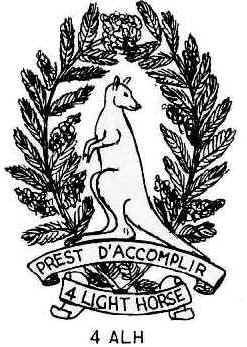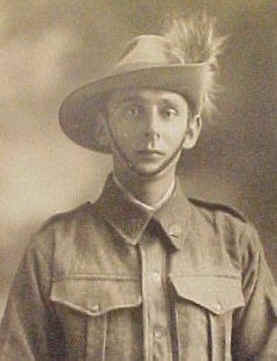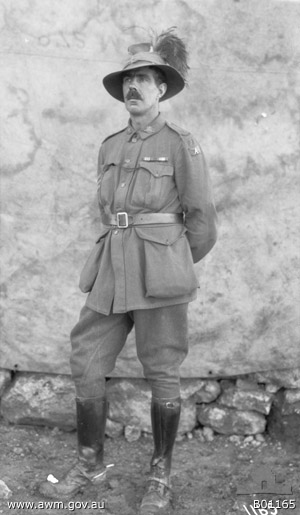 |
| Category:
Lt Horse Regiments |

|
|
|
|
|

4th
Light Horse Regiment (Victoria)
[4th
Light Horse Brigade]
Served in Egypt, Gallipoli, Sinai, Palestine, Western Front
The main
body of the regiment was attached to 1st
Light Horse Brigade March 1916.
It was redesignated 3rd
Camel Regiment September 1916 but a shortage of camels prevented its
transformation into a camel regiment. Resumed its old designation and
brought up to strength again in February 1917 and assigned to the
reformed 4th Light Horse Brigade.
Badge displayed either
unofficial or CMF. |
 |
- Formed Victoria August 1914 for 1st Division.
- Departed Melbourne on Wiltshire
18 October 1914.
- B squadron sent to the Western Front in March 1916
- and
formed part of I Anzac Corps
Mounted Regiment and later
- II
Anzac Corps Mounted Regiment from 2 July 1916.
- D Squadron formed at
Tel El Kebir, Egypt 11 March 1916 for service in France where it formed
part of II Anzac Corps
Mounted Regiment from 2 July 1916.
- B and D Squadrons, assigned to II
Anzac Corps Mounted Regiment, wore its patch
- 1st Reinforcements departed Melbourne on
Barunga
22 December 1914,
- 2nd Reinforcements departed Melbourne on Katuna
3 February 1915,
- 3rd Reinforcements departed Melbourne on Katuna
3 February 1915,
- 4th Reinforcements departed Melbourne on Wiltshire
13 April 1915,
- 5th Reinforcements departed Melbourne on Palermo
7 May 1915,
- 6th Reinforcements departed Sydney on Ceramic
25 June 1915,
- 7th Reinforcements departed Melbourne on Persia
10 August 1915,
- 8th Reinforcements departed Melbourne on Kyarra
20 August 1915,
- 9th Reinforcements departed Melbourne on Hororata
27 September 1915,
- 10th Reinforcements departed Melbourne on Ballarat
9 September 1915,
- 11th Reinforcements departed Melbourne on Palermo
29 October 1915,
- 12th Reinforcements departed Melbourne on Ceramic
23 November 1915,
- 13th Reinforcements departed Sydney on Runic
20 January 1916,
- 14th Reinforcements departed Melbourne on Themistocles
28 January 1916,
- 15th Reinforcements departed Melbourne on Katuna
9 March 1916
- 16th Reinforcements departed Melbourne on Itria
18 April 1916,
- 17th Reinforcements departed Melbourne on Clan
MacCorquodale 6 May 1916,
- 18th Reinforcements departed Melbourne on
Runic
20 June 1916,
- 19th Reinforcements departed Melbourne on Mongolia
11 Ju1y 1916
- 20th Reinforcements departed Melbourne on Malwa
25 July 1916
- 21st Reinforcements departed Melbourne on
Nestor
29 September 1916,
- 22nd Reinforcements departed Melbourne on Clan
MacCorquodale 19 September 1916,
- 23rd Reinforcements departed Melbourne on
Persic
22 December 1916,
- 24th Reinforcements departed Melbourne on Orsova
16 December 1916,
- 25th Reinforcements departed Melbourne on Omrah
17 January 1917,
- 26th Reinforcements departed Melbourne on Ascanius
11 May 1917,
- 27th Reinforcements departed Melbourne on Boorara
10 May 1917 and Suevic
21 June 1917,
- 28th Reinforcements departed Melbourne on Port
Lincoln 22 June 1917,
- 29th Reinforcements departed Sydney on Anchisses
8 August 1917
- and Melbourne on Kyarra
7 September 1917,
- 30th Reinforcements departed Melbourne on Commonwealth
2 November 1917
- 31st Reinforcements departed Melbourne on Ulysses
22 December 1917
- 32nd Reinforcements departed Sydney on Wiltshire
2 February 1918,
- 33rd Reinforcements departed Sydney on Canberra
16 November 1917,
- 34th Reinforcements departed Sydney on Ulysses
19 December 1917.
 |
 |
|
Unidentified
Lighthorseman from 4ALH Regt |
968
Sergeant Herbert Charles Robertson MM, 4th Australian Light Horse
Regiment. He also served in 4 (Qld Imperial Bushmen Contingent) in
the Boer War. Australian Commonwealth Horse, who all enlisted in
South Australia. He is wearing the Queens's South African campaign
medal. A small badge in the form of the letter "A" on
unit colour patche denotes that the wearer had taken part in the
1915 Gallipoli campaign. |
Battle Honours:
- Anzac,
- Defence of Anzac,
- Suvla,
- Sari
Bair,
- Gallipoli 1915,
- Egypt 1915-17,
- Gaza-Beersheba,
- El Mughar,
- Nebi Samwil,
- Jerusalem,
- Jordan (Es Salt),
- Megiddo,
|
- Nablus,
- Sharon,
- Damascus,
-
Palestine 1917-18,
- Messines 1917,
- Ypres 1917,
- Broodeseinde,
- Passchendale,
-
Lys,
- Kemmel,
- Marne 1918,
- Tardenois,
- France and Flanders 1916-18
|
|
many details on this page from Ross
Mallett's site
|
|
4th Light Horse Regiment
The 4th Light Horse Regiment was formed
as the divisional cavalry regiment for the 1st Australian Division on 11
August 1914. Belying traditional stereotypes, over 20 per cent of the
original regiment were city dwellers from Melbourne. The regiment sailed
from Melbourne on 19 October 1914 and disembarked in Egypt on 10 December.
The light horse were considered
unsuitable for the initial operations at Gallipoli, but were subsequently
deployed without their horses to reinforce the infantry. The 4th Light
Horse Regiment landed on 22 and 24 May and its squadrons were initially
scattered to reinforce the infantry battalions already ashore. The
regiment was not reunited until 11 June. Much of the regiment’s time at
Gallipoli was spent defending the precarious ANZAC position, most
frequently around Ryrie’s Post, but its squadrons were involved in
several minor attacks. It left the peninsula on 11 December 1915.
Returning to Egypt, a fourth squadron
– “D Squadron” – was formed for the regiment and it was promptly
detailed, along with B Squadron, for duty as divisional cavalry for the
1st and 3rd Australian Divisions on the Western Front. These two squadrons
arrived in France in March and June 1916 and would eventually become part
of the II ANZAC Mounted Regiment.
A new B Squadron was formed for the 4th
Light Horse in Egypt, and the regiment spent the remainder of 1916 engaged
on rear area security tasks in the Suez Canal Zone. In April 1917 it moved
up into the Sinai desert in the wake of the main British and dominion
advance, but continued to undertake security duties.
The regiment’s first major battle
would also become that which made it legendary. On 31 October 1917 an
attack was launched to outflank the Turkish bastion of Gaza, against which
two previous attacks had failed, by capturing another heavily defended
town to the east – Beersheba. A deteriorating tactical situation late on
the first day of the operation caused the 4th and its sister regiment, the
12th, to be unleashed on Beersheba at the gallop – an action which has
gone down in history as the charge of Beersheba.
After Gaza fell on 7 November 1917,
Turkish resistance in southern Palestine collapsed. The 4th Light Horse
participated in the pursuit that followed, and then spent the first months
of 1918 resting and training. It moved into the Jordan Valley in time to
participate in the Es Salt raid between 29 April and 4 May.
In August, the regiment was issued with
swords and trained in traditional cavalry tactics in preparation for the
next offensive against the Turks. This was launched along the Palestine
coast on 19 September 1918 – its objective, Damascus. The mounted forces
penetrated deep into the Turkish rear areas severing roads, railways and
communications links. On 1 October 1918, a patrol of the 4th Light Horse,
commanded by Sergeant Frank Organ, were the first allied troops to enter
Damascus.
The regiment was soon involved in the
next stage of the advance and was on its way to Home when the Turks
surrendered on 30 October. Some long-serving troopers began to embark for
home soon after and while the rest awaited their turn, the 4th Light Horse
were called back to operational duty to quell the Egyptian revolt that
erupted in March 1919; order was restored in little over a month. The
regiment sailed for home on 15 June 1919. text from AWM
- 105 killed, 332 wounded
(Gallipoli, Egypt, Sinai and Palestine only.)
-
Decorations
- 4 DSO, 1 bar
- 1 OBE
- 6 MC, 1 bar
- 14 DCM
- 43 MM, 1 bar
- 1 MSM
- 31 MID
- 4 foreign awards
|
|